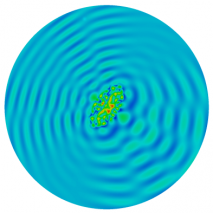The development of efficient approaches to simulate seismic wave propagation in complex geological structures is crucial to predict the consequences of large earthquakes. In recent projects (QSHA, MARS, SINAPS@, EUROSEISTEST) high-performance realistic numerical simulations of wave propagation in sedimentary basins have proved useful to assess site amplification and spatial variability. Numerical tools based on domain or boundary discretization such as the Spectral Element Method and the Boundary Element Method are capable to generate accurate ground motions in the range of 0-10 Hz.
In this project the state-of-the-art techniques of computational seismology will be improved and applied to study the physics of surface wave propagation on basins with realistic geometries and heterogeneities. Furthermore, studies with generic sedimentary basin models will provide useful guidance in assessing the effect that the near-surface (~100 m) soft deposits have on long period motions. Do these soft and shallow sediments have an effect on long period surface waves? The seemingly obvious answer that shallow soft sediments do not affect long period basin-induced surface waves may not be entirely correct.
Numerical simulation of long-period ground motion
Although there exists an extensive bibliography concerning the effect of basin or valleys on surface waves generation, most of those works have focused on i) 2D or 3D idealized geometries, ii) homogeneous media; iii) elastic soil behaviour and iv) idealized input motions.
In the project, numerical simulations will be first performed in 2D/3D canonical basins in a benchmark exercise to verify the capabilities to describe the dispersive characteristics of surface waves by the numerical tools that will be implemented in this WP. An important question when extracting surface waves from time histories is whether such waves are generated by the conversion of body waves at the free surface outside the basin, or whether the conversion takes place at the edge of the basin or the edge of some surficial layers. Identifying the type of surface waves that have a more important effect at a site is an important question when studying “basin effects”. With a proper model for the basin structure and source radiation, numerical simulations can lead to the identification of the conditions which warrant the generation of basin-edge generated surface waves.

Then, we will perform numerical simulations with simplified and realistic 2D/3D geometries and geological models to cross-verify the capabilities of our numerical tools to simulate surface wave dispersion and amplification. Compatibility with ground motions generated with the stochastic model (WP2) will be assessed for this purpose. We will consider well-known basins around the world (Los Angeles, Nagoya, Argostoli basins). These basins are attractive because of i) the good preexisting geological, geophysical, and geotechnical characterization to construct a 3-D physics-based numerical model of the site surroundings (approx. within a radius of 30-50 km) and ii) the sufficient number of available recordings from adequately deployed seismic stations. Also for models of these realistic basins we will conduct performance tests, and with the development of misfit functions we will assess the goodness of fit (in the low-frequency range) among the simulations (numerical and stochastic) and the observations. This research effort is directed to reduce the gap between observed and simulated ground motions, in regards to both low-frequency amplification and duration.
WP leader: Jean-Francois Semblat (ENSTA)


